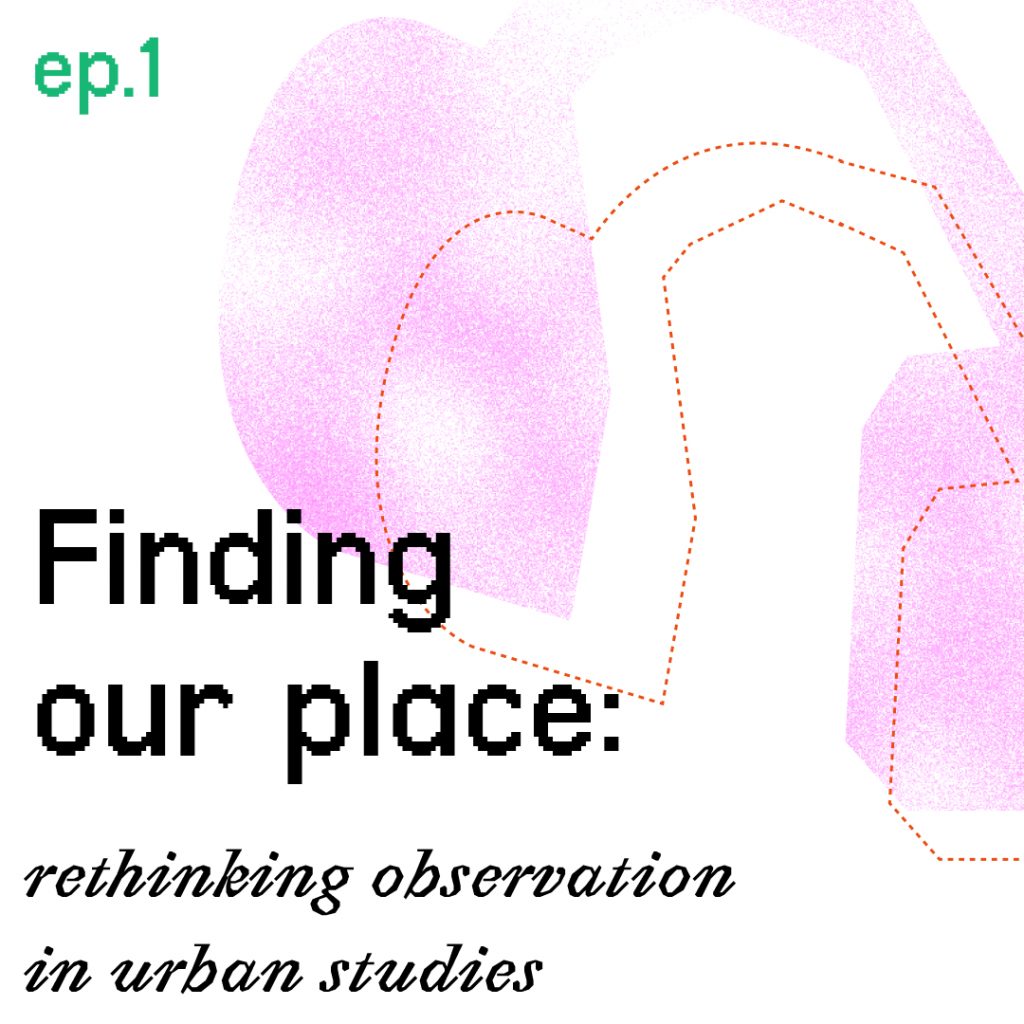
CYCLE 1 / EPISODE 1
Finding our place: rethinking observation in urban studies
This episode delves into the multifaceted practice of observing urban spaces, challenging traditional approaches that rely solely on quantitative data. It emphasizes the need to integrate intangible elements—such as emotions, sensory experiences, and human interactions—into urban and spatial analysis to fully understand the dynamics of places.
Drawing on insights from scholars like Gloria Calderone, Barbara Piga, and Lizzy Privitera, the episode explores innovative observation methods, including community-led walks, psychogeography, and bodygraphy, which highlight the importance of embodied experiences and interdisciplinary collaboration. By reflecting on the role of scholars as active participants in the observation process, the episode calls for a more inclusive and dynamic understanding of urban environments, one that recognizes the evolving and subjective nature of these spaces. This perspective fosters a richer, more democratic approach to urban studies, planning, and design.
Subscribe on your favorite platform
Guests
Resources
Suggested readings
Armiero, M., Andritsos, T., Barca, S., Bràs, R., Cayuela, S. R., Dedeoğlu, Ç., Pierri, M. D., De Oliveira Fernandesisa, L., Gravagno, F., Greco, L., Greyl, L., Iengo, I., Lindblom, J., Milanez, F., Pedro, S., Pappalardo, G., Petrillo, A., Portaluri, M., Privitera, E., Sari, A. C., & Velegrakis, G. (2019). Toxic Bios: Toxic Autobiographies – A Public Environmental Humanities Project. Environmental Justice, 00(00), 1–5. https://doi.org/10.1089/env.2018.0019
Britto, F. D., & Jacques, P. B. (2009). Bodycity: art as urban micro-resistance. Fractal Revista de Psicologia, 21(n. 2), 337–350.
Calderone, G. (2024). Corprogettazioni. Posture performative per coreografare la città. Gli Ori.
Calderone, G., & Mandalari, V. (2024). Performing spatial atmospheres to awaken places: the case of the project Sulla Soglia in Palermo. In M. Boubezari, C. R. Duarte, & E. Pinheiro (Eds.), Sensory Explorations, Ambiances in a Changing World: Proceedings of the 5th International Congress on Ambiances. International Ambiances Network. Lisbon, Portugal.
Careri, C. (2017 [2002]). Walkscapes: Walking as an Aesthetic Practice. Ames, IA: Culicidae Architectural Press.
Chadwick, R. (2017). Embodied methodologies: Challenges, reflections and strategies. Qualitative Research, 17(1), 54–74.
Chang, H. (2016). Autoethnography as a Method. In Paper Knowledge. Toward a Media History of Documents. Routledge.
Code, L. (1991). What can she know? Feminist theory and the construction of knowledge. Cornell University Press, Ithaca.
Corburn, J. (2005). Street Science: Community Knowledge and Environmental Health Justice. Cambridge, MA: MIT Press.
Cranz, G. (2016). Ethnography for designers. In Ethnography for Designers. Routledge.
de Certeau, M. (1980). L’invention du quotidien. Union générale d’éditions.
Decandia, L. (2000). Dell’identità. Saggio sui luoghi per una critica della razionalità urbanistica. Soverio Manelli: Rubettino.
Edensor, T., & Bowdler, C. (2015). Site-specific dance: Revealing and contesting the ludic qualities, everyday rhythms, and embodied habits of place. Environment and Planning A, 47(3), 709–726.
Haraway, D. J. (1991). Situated knowledge: The science question in feminism and the privilege of partial perspective. In D. J. Haraway (Ed.), Simians, Cyborgs, and Women: The Reinvention of Nature (pp. 183–201). London: Free Association Books.
Harding, S. (1995). Strong objectivity: A response to the new objectivity question. Synthese, 104, 331–349.
Mallgrave, H. F. (2013). Architecture and Embodiment. The Implications of the New Sciences and Humanities for Design. Routledge.
Micarelli, R., & Pizziolo, G. (2003). Dai margini del caos: L’ecologia del progettare. Florence, Italy: Alinea.
Micarelli, R., & Pizziolo, G. (2003). L’arte delle relazioni. Florence, Italy: Alinea.
O’ Neill, M., & Roberts, B. (2020). Walking methods: Research on the move. Routledge.
Privitera, E. (2024). (Counter)mapping toxic legacies: A small, slow, and street approach in the risk landscapes of Gela. Officina, 47, 40–49. https://www.officinajournal.it/officina/index.php/journal/article/view/47_4
Privitera, E., & Gravagno, F. (2020). A street-explorative and interactive-designing laboratory: Notes from an experience of creating a deutero-laboratory and applying deutero-learning in the Sicilian neighborhood of San Berillo (Catania, Italy). The Urban Transcripts Journal, Special Issue “The Space of the (Re)Public,” 3(1). https://journal.urbantranscripts.org/article/a-street-explorative-and-interactive-designing-laboratory-elisa-privitera-and-filippo-gravagno/
Privitera, E., Armiero, M., & Gravagno, F. (2021). Seeking justice in risk landscapes: Small data and toxic autobiographies from an Italian petrochemical town (Gela, Sicily). Local Environment: The International Journal of Justice and Sustainability, 26(7), 847–871. https://doi.org/10.1080/13549839.2021.1922999
Sandercock, L. (2003a). Cosmopolis II: Mongrel Cities of the 21st Century. London, UK: Continuum.
Sandercock, L. (2003b). Out of the closet: The importance of stories and storytelling in planning practice. Planning Theory & Practice, 4(1), 11–28. https://doi.org/10.1080/1464935032000057209
Sclavi, M. (2003). L’arte di ascoltare e mondi possibili. Milan: Bruno Mondadori.
Springgay, S., & Truman, S. E. (2018). Walking Methodologies in a More-than-Human World: WalkingLab. Routledge.
Spry, T. (2001). Performing Autoethnography: An Embodied Methodological Praxis. Qualitative Inquiry, 7(6), 706–732.
Stengers, I. (2018). Another Science is Possible: A Manifesto for Slow Science. Cambridge, UK: Polity Press.
Sweet, E. L., & Ortiz Escalante, S. (2015). Bringing bodies into planning: Visceral methods, fear and gender violence. Urban Studies, 52(10), 1826–1845.
Sweet, E. L., Sanders, R., & Peters, D. M. (2021). Reversing the gaze, insiders out, outsiders in: Stories from the ivory tower and the field. Journal of Urban Affairs, 43(7), 1028–1041.
Whybrow, N. (Ed.). (2021). Urban Sensographies. Routledge.
Zardini, M. (2005). Toward a Sensorial Urbanism. In M. Zardini (Ed.), Sense of the City: An Alternative Approach to Urbanism. CCA/Lars Müller Publishers.